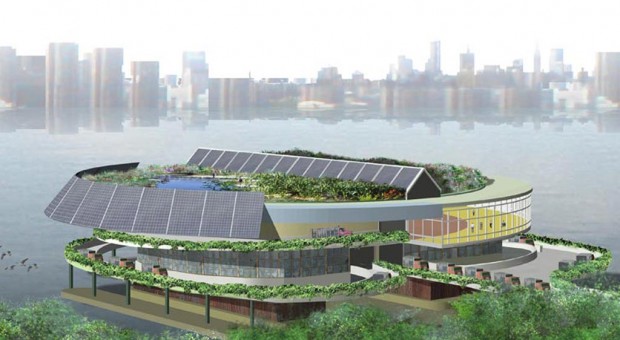- NYC Marine Transfer Stations
NYC Marine Transfer Stations

Manhattan, New York, 2004
In 2004, the New York City office of the Environmental Defense Fund (EDF) Living Cities Program asked Michael Singer to investigate and re-imagine the design of the then defunct NYC Marine Transfer Station (MTS) facilities. At the time EDF was spearheading a community led environmental justice movement to reopen the waterfront MTS facilities throughout the City in order to more equitably distribute the collection, handing, consolidation and transfer of waste and recycling in New York City. After the MTS facilities closed in 1996, commercial and residential waste and recycling became solely land based with transfer facilities primarily located in the least economically developed parts of the City (with no facilities in Manhattan). After intensive study, EDF and its community partners launched a campaign to show how equitably reintroducing the MTS facilities within all boroughs of the City could reduce truck traffic and pollution by over 50% and take the unjustifiable environmental burden off of the poorest communities in the City. This campaign is outlined in Trash and the City published by EDF which became an influential document in helping to shape the City’s Solid Waste Management Plan (SWMP).
Michael Singer became involved when EDF and its allies needed to present a credible concept for what the new MTS facilities would look like and how they would function. The EDF plan and the City’s SWMP proposed re-establishing the network of MTS facilities that had to pass the scrutiny of community boards, the City Council and local activist groups. This issue was especially critical for Manhattan waterfront sites that would face significant opposition. Singer was tasked with creating a new vision for the MTS facilities based on his prior work transforming the 27th Avenue Solid Waste and Recycling Transfer Facility in Phoenix Arizona.
The Singer Team investigation revealed many strategies to re-imagine the MTS facilities in both function and form. The primary design challenge was a functional issue: the most significant community complaint of the existing and obsolete transfer facilities was the long queue of smelly, noisy trucks in local streets. To address this issue the Singer Team envisioned the facility wrapped in a continuous automated ramp that would accommodate a long queue of non-idling trucks within the facility rather than on the streets and in adjacent neighborhoods. Every aspect of the proposed MTS design – walls, roofs, and interior spaces – supports its function. Water collected from the roof is stored in wall cavities for cleaning the garbage trucks and facility. Plantings along the walls and on the roof treat wastewater, remove odors through air-to-soil filtration and offer a flyway habitat stop for migrating birds. Solar photovoltaic panels generate power for a significant portion of the facility’s needs. The design proposed a layout for storing trucks within the transfer facility itself allowing the land adjoining the MTS (historically used to store the trucks) to be transformed into a spacious waterfront park and gardens for pubic enjoyment. Given the scale of the facility, some of the ample interior space of the MTS was proposed to be used for community activities, educational programs and offices for local organizations.
The Singer Team MTS design played a vital role in supporting EDF, its allies and the City in gaining support and NY State approval for the SWMP. In 2006 the SWMP was passed and approved by all necessary authorities. Unfortunately, most of the new MTS facilities are being built with little consideration of the designs put forth by EDF and the Singer Team. Accordingly several of the new MTS facilities have been repeatedly delayed by communities and activists concerned about environmental, aesthetic and economic impacts on their neighborhoods.
The executive summary of EDF’s original report Trash and the City can be found here.
On Op Ed in the New York Times on this project can be read here.
Artist/Designer: Michael Singer
Michael Singer Studio Project Team: Peter Nobile, Calen Colby PE,
Michael Fishman, Trevor Lee, John Guminak
Singer Studio Public Policy Advisor: Nancy Rutledge Connery
Environmental Defense: Ramon Cruz, Project Manager and
Andy Darrel, NYC Regional Director

